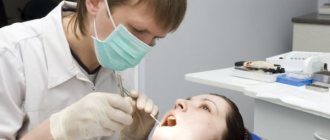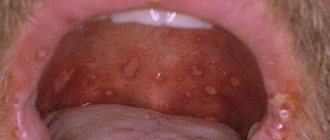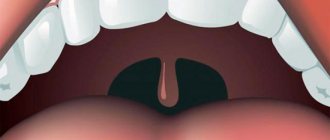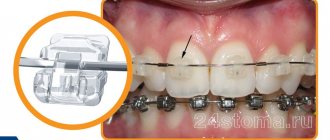How does inflammation occur?
About 70% of acute inflammatory diseases of the pharynx are caused by viruses2. In acute viral infections, the most common symptoms include: sore throat, weakness, cough, and fever. In children it is high (38 degrees and above), and in adults it is within 37-38 degrees. Of course, the intensity of the temperature depends on the specific pathogen: for example, during the flu it rises sharply above 38 degrees, and rhinoviruses, for example, practically do not cause high fever. In addition, other symptoms appear: headache, sweating, chills.
Today, about 250 viruses are known that can cause a “cold.” The most common of them are rhinoviruses, adenoviruses, Epstein-Barr virus, Coxsackie virus, coronavirus1.
In addition to viruses, acute inflammation of the pharynx is caused by bacterial and fungal infections. The most common cause of sore throat is streptococcus pyogenes. A bacterial infection feels almost no different from a viral one: the same high temperature, the same manifestations of intoxication. But it is possible to become infected with several bacteria at once - for example, streptococcus and Staphylococcus aureus. These bacteria are dangerous because... can provoke the development of pneumonia, therefore, if the temperature rises sharply and you feel weak and dizzy, you should urgently consult a doctor to determine the disease. There are also rapid tests that quickly help determine the cause of the disease (for example, the causative agent of a sore throat) even at home.
Don't discount fungal flora either. The most common pathogen in this case is the fungus Candida albicans, better known among the people as the “causative agent of thrush” - they cause almost every second fungal inflammatory process of the nasopharynx3.
But the most common option is mixed flora. The virus that originally caused the disease “prepares the ground” for a bacterial infection, which easily develops on the inflamed mucous membrane, which has lost its natural protective properties. Taking certain antibiotics can also become a catalyst, in which case a fungal infection will occur.
Prolonged sore throat is caused by bacteria and fungi, which are a source of chronic infection, for example, with sinusitis, tonsillitis or caries.
In children, constant soreness can be caused by inflammation of the palatine tonsil - adenoiditis - with the main irritating factor being the inflammatory secretions flowing down the back wall of the pharynx.
Types of pain
“Anything can hurt: the back wall of the pharynx, the tonsils, the hypopharynx, the nasopharynx, the epiglottis with the root of the tongue,” says Vladimir Zaitsev. The main thing is to understand that there is a difference in sensations with one or another localization of pathogenic microorganisms.
1. Pain worsens when swallowing
One of the options for soreness in the throat area is pain, which intensifies when swallowing. At the same time, it is not sharp, diffuse, but intensifies when swallowed and swallowed. Here doctors usually talk about the most common situation: acute pharyngitis. “When a person became hypothermic, the back wall of the throat became cold, and it became inflamed. At the same time, there is no mucus flowing down the back wall, the throat just hurts,” notes the ENT doctor. You can go to the mirror, shine it with a flashlight and see redness on the back wall. And it will also be spilled all over the back wall.
Article on the topic
Throat hazard. Why does laryngeal cancer develop?
Here it is worth understanding, the otolaryngologist emphasizes, that if a person ignores this situation and does not begin to be treated, then the disease may progress to the chronic stage. “In this case, the pain will also change its character: instead of acute pain when swallowing, there will be a feeling of dryness of the back wall, its complete dryness, then there will be a feeling of rawness, soreness, burning, and there may be a desire to drink something or even put oil drops in the nose, to soften the wall of the pharynx,” says Vladimir Zaitsev. He emphasizes that the condition cannot be ignored. You can also see that the mucous membrane is suffering from dryness by looking in the mirror: it will be noticeable that it is not filled with water.
2. Sore throat is associated with the nose
Another type of pain appears when, for example, the tonsils are removed, or if a person has problems with the nose that lead to sleep apnea, snoring and the fact that his mouth is constantly open during sleep. “Such a situation will sooner or later lead to subatrophic pharyngitis. Due to the constant drying of the back wall of the pharynx, the mucous membrane will stop working as it should,” says Vladimir Zaitsev.
It makes noise, itches, it doesn't breathe. Non-serious symptoms of serious ENT diseases Read more
3. Aching pain on the right and left
There may also be a problem when there is bad breath, weakness, lethargy and an aching sore throat, discomfort in the throat. This is what the condition of chronic tonsillitis or exacerbation of chronic tonsillitis looks like. “When there is a history of it, pain and discomfort do not appear in the center of the pharynx, but the pain will be localized on the sides: on the right and left. Also, against the background of such pain, low-grade fever appears: its values rise to 37.3-37.5 degrees. At the same time, plugs in the tonsils will be visible, such small white curdled grains,” notes Vladimir Zaitsev.
Article on the topic
Viral throat infections: symptoms, treatment
4. Throat hurts sharply and constantly
If the pain in the throat is unbearable and sharp, the temperature jumps above 38.5, and a scarlet throat is visible, very painful, then with a high degree of probability we are talking about acute catarrhal sore throat. “The temperature is high, the pain is very strong, sometimes it doesn’t even allow you to swallow saliva, as a result of which it just starts flowing from the mouth, it even gets to this point,” says the otolaryngologist.
5. Pain in the neck area
When hoarseness appears, this indicates that the inflammation has moved from the oropharynx just below, to the larynx, says the ENT doctor. “When there is acute inflammation of the larynx, acute laryngitis develops. However, it will not necessarily be accompanied by a complete absence of voice (aphonia); dysphonia may also be present. Here, too, against the background of incomplete closure of the ligaments, pain will appear. But it will not be localized at the level of the palate or along the back wall of the pharynx. It will be marked slightly lower, at neck level. The person himself will even point to his neck, describing his condition,” says Vladimir Zaitsev. Laryngitis, as the otorhinolaryngologist emphasizes, can be subacute, acute and chronic.
And it definitely needs to be treated. “If laryngitis is not treated, the inflammation may go away, but hoarseness may remain. The vocal cords will get stuck in this state, settle down, and the person will continue to live with this hoarseness forever,” says the specialist.
Killer bones, melted plasticine. How to kill foreign bodies in the throat and ear Read more
6. Pain in the epiglottis area with suffocation
“The epiglottis is a kind of flap, a petal that closes the entrance to the trachea, and, for example, when taking a sip of water or swallowing food, it protects the organ from water and food entering further into the trachea, lungs and bronchi,” notes the doctor. At the same time, there are situations when this well-coordinated system fails. This could be:
- against the background of decreased immunity;
- during extreme heat;
- in case of injury.
In all these cases, the epiglottis can become inflamed and noticeably increase in size. “Here a characteristic pain appears, which cannot be confused with anything: suffocation, squeezing pain not at the level of the oropharynx, but slightly below, there is a feeling of lack of air. This is a bright moment, it’s called epiglottitis,” says Vladimir Zaitsev. In an acute situation, they say that the epiglottis increases in size, swells, is tense and red; naturally, therapy is required, usually with antibiotics.
There is also a situation when an abscess of the epiglottis develops: this is already a purulent process, when opening of the formation and its cleaning is required.
Article on the topic
Mushroom place. How to get rid of mycoses in the throat and ears?
7. The root of the tongue hurts
There is also such an option as inflammation of the root of the tongue. There is a lingual tonsil on it, notes the otorhinolaryngologist, which is part of the lymphoid tissue. The root of the tongue may become inflamed on its own. A lingual sore throat develops. “The temperature is as high as with a sore throat, but a person reflexively feels pain at the level of the tongue, but not at the tip or from the sides, but in the very depths. A feeling of suffocation may also develop because the airways are nearby,” says Vladimir Zaitsev.
It is also worth remembering that there is a condition when it is not so much pain that develops, but a burning sensation, itching, a desire to scratch, and there may also be slight soreness. In such a situation, notes Vladimir Zaitsev, they talk about pharyngomycosis, that is, a fungus in the throat.
How to understand that salivation is increased: symptoms and signs of failure
Saliva is involved in many important processes occurring in the human body. When everything is normal, we do not notice that saliva:
● helps to pronounce words and sounds clearly and correctly;
● enhances the perception of the taste of food and drinks;
● participates in digestion - helps to chew food and also swallow it.
When salivation is increased, several processes are disrupted at once:
● the taste of food changes - salty food becomes too pronounced, and subtle nuances are not felt;
● problems with diction appear – pronouncing some sounds is problematic;
● it becomes painful to swallow food.
Location of glands
In addition to indirect signs, there are also clear, measurable criteria. If more than two milliliters of saliva is released within five minutes, the patient is diagnosed with increased salivation. The normal value is 2 ml.
Sometimes patients complain of false profuse salivation. This happens when there is injury or inflammation in the mouth and it may seem that there is more saliva than there should be, although the levels are normal: 2 ml in 5 minutes or 2 liters per day.
What to do?
Of course, says the ENT doctor, every person can look into his own throat with the help of an ordinary flashlight and mirror. However, you should not turn into your own doctor, warns Vladimir Zaitsev. “Because, for example, the use of antibiotics where it is not required, but antiseptics are needed, can seriously harm. For the same pharyngomycosis, the use of antibiotics will further suppress the flora and allow more active growth of fungi. It is also dangerous not to use antibiotics where they are required. And only a doctor can determine exactly what exactly, in what situation and what courses will be required,” says Vladimir Zaitsev. This means that if you experience a sore throat, an in-person examination and the prescription of adequate therapy are required.
There are contraindications. Be sure to consult your doctor.
Imudon® for sore throat
The drug has a wide spectrum of action and is used for diseases caused by viruses, bacteria and fungi. Imudon® contains lysates of bacteria and fungi of the genus candida4 - that is, the most common infectious agents, which helps activate the body's protective immune reactions against them. Viruses are affected by interferons and lysozyme, which the body produces itself during the use of the drug. Therefore, Imudon® is effective for both acute and chronic diseases that cause a sore throat in children and adults5,6,7.
Increased salivation in women during pregnancy
A common cause of hypersalivation in women is pregnancy. When a woman is preparing to become a mother, the hormonal background of the body changes greatly, and with it many processes: blood circulation, digestion.
Pregnancy affects all systems at once:
● endocrine;
● nervous;
● digestive.
Often, expectant mothers experience problems with their teeth and gums, such as gingivitis. This disease also affects the amount of saliva produced.
Healthy and inflamed gums
Causes of increased salivation in men and women
The volume of saliva secreted is controlled by the nervous system. When everything is in order with health, it happens naturally and unnoticed by a person. But when problems arise or diseases appear, the process is disrupted. A variety of factors can influence, but most often the cause of increased salivation in adult men and women is one of six factors.
- Oral diseases - gum inflammation, periodontitis, stomatitis, as well as cuts and burns. When bacteria enter the glandular tubules, the body begins to produce more saliva to get rid of them. This is a natural reaction.
- Digestive system problems - abnormal stomach acidity, pancreatic and liver diseases.
- CNS diseases - Parkinson's disease, trigeminal nerve damage, bulbar syndrome, migraine. With these diseases, the natural process of salivation is disrupted. Short-term impairment may occur due to air sickness, seasickness, or problems with the vestibular apparatus.
- Hormones - failures of the hormonal system, in particular the thyroid gland, menopause, diabetes mellitus lead to excessive salivation. Sometimes this is observed in adolescents during the restructuring of the body.
- Smoking and removable dentures can also affect it. Both of these phenomena irritate the mucous membrane, stimulating the overactive functioning of the glands.
- Taking medications - some medications have side effects of increased salivation or, as it is also called, hypersalivation. Most often these are those medications that contain iodine or mercury. For example: lithium, physostigmine, muscarine.
Pilocarpine, nitrazepam also lead to hyperactivity of the glands
What to do with increased salivation depends on the factors that caused it. In some cases, for example, when taking medications, the disease will go away without the intervention of a doctor.
Symptoms
When mucous masses constantly “stand” in the throat, the patient wants to swallow them. Such actions (if the secretion is too thick) can cause vomiting and nausea. This condition usually occurs in parallel with other characteristic signs that patients complain about when visiting an ENT doctor:
- sore throat;
- a feeling of a lump in the throat that cannot be gotten rid of;
- a constant desire to cough, although the cough does not bring relief; coughing attacks are especially severe at night;
- discomfort when swallowing food;
- bad breath caused by pathogens multiplying in the throat;
- swollen lymph nodes;
- Loud snoring.
To understand how to treat a sore throat, you need to consult an ENT doctor to determine the cause of postnasal drip.
Treatment of increased salivation
Depending on the cause of hypersalivation, different doctors provide treatment:
● dentists solve problems of local oral diseases;
● endocrinologists for hormonal disorders;
● gastroenterologists, if the problem is diseases of the digestive system;
● neurologists, if the failure is due to problems with the central nervous system.
A dentist will help identify the cause, and a therapist will refer you to a specific specialist.
Treatment with medications
In addition to eliminating the causes associated with disruption of the internal organs, the doctor may prescribe medications that eliminate the symptoms. For example:
● riabal;
● scopolamine;
● platiphylline.
Taking medications without a doctor's prescription is prohibited!
We do not recommend purchasing or taking medications without consulting a doctor. Each drug has contraindications and side effects: from glaucoma to liver, heart, and vascular diseases.
You should not risk your life and health to save time or money on a visit to the clinic.
Botox treatment
For short-term symptom relief, Botox injections are sometimes used. It blocks nerve signals, reducing tubule activity. This method helps to quickly get rid of the problem, but, unfortunately, the effect does not last long.
Facial massage and muscle relaxation
It will help if the cause is related to nervous tension, stress or central nervous system pathologies.
Removal of glands
It is prescribed extremely rarely, only in cases where all other methods and elimination of the causes of the disease have not helped. Removal, even partial, can damage the facial nerves.











